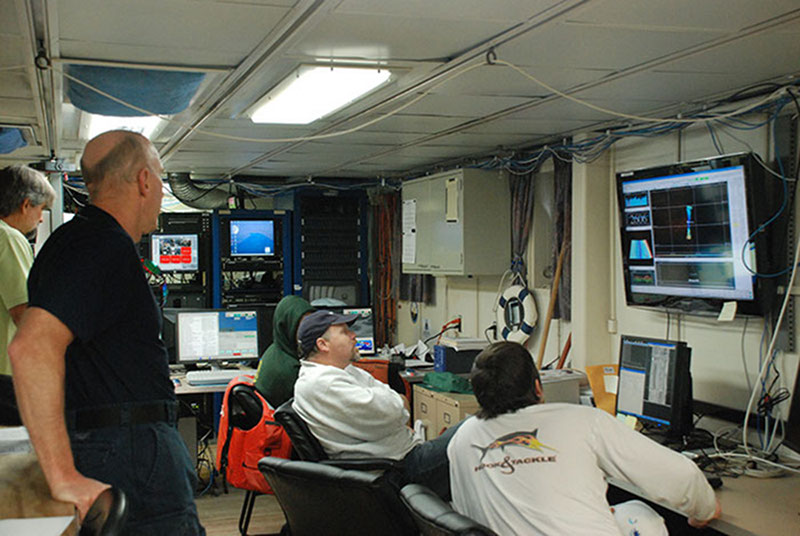
Ocean Explorer Expedition Education Modules (EEM) are designed to reach out in new ways to educators, students, and the general public, and share the excitement of daily at-sea discoveries and the science behind NOAA’s major ocean exploration initiatives with the people around the world. The Deepwater Canyons 2013 - Pathways to the Abyss expedition offers a unique opportunity to engage explorers of all ages as we continue our journeys to parts of our ocean planet that few have seen -submarine canyons of the U.S. mid-Atlantic continental slope.
Dr. Steve Ross and Dr. Sandra Brooke discuss the nature of their work and how it is used to protect the ocean ecosystem. View the full OceanAGE Career interviews with Dr. Ross and Dr. Brooke. Note that Dr. Brooke has transitioned jobs since the original interview filming. Video courtesy of Deepwater Canyons 2013 - Pathways to the Abyss, NOAA-OER/BOEM/USGS. Download (mp4, 5.3 MB).

A summary of why scientists and educators are interested in exploring this area and what we might learn from our efforts in this region as we strive to further understand the 95% of our planet that is virtually unexplored.
Learn more
A collection of lesson plans for students in grades 5-12 has been specifically designed for this expedition. These lessons support the Next Generation Science Standards and the Ocean Literacy Essential Principles and Fundamental Concepts . You will also find links to other lesson plans residing on the Ocean Explorer website that have been developed for previous NOAA expeditions, and have content that relates to the Deepwater Canyons 2013 - Pathways to the Abyss expedition.
The Multimedia Discovery Mission Demos are a series of 14 interactive multimedia presentations and learning activities that address topics ranging from Chemosynthesis and Hydrothermal Vent Life and Deep-sea Benthos to Food, Water and Medicine from the Sea.
Ocean Careers to Inspire Another Generation of Explorers, or OceanAGE Careers, invites students to learn about the talented people who explore our ocean planet.
The web links below are provided for informational purposes only. Links outside of Ocean Explorer have been checked at the time of this page's publication, but the linking sites may become outdated or non-operational over time.
Davies, A. J., G. C. A. Duineveld, M. S. S. Lavaleye, M. J. N. Bergman, H. van Haren, and J. M. Roberts, 2009. Downwelling and deep-water bottom currents as food supply mechanisms to the cold-water coral Lophelia pertusa (Scleractinia) at the Mingulay Reef complex. Limnol. Oceanogr. 54(2):620-629.
De Leo, F. C., C. R. Smith, A. A. Rowden, D. A. Bowden, and M. R. Clark. 2010. Submarine canyons: hotspots of benthic biomass and productivity in the deep sea. Proc. Biol. Sci. 277(1695):2783-2792.
Hecker, B. and G. Blechschmidt. 1979. Final Historical Coral Report for the Canyon Assessment Study in the Mid- and North-Atlantic Areas of the U.S. Outer Continental Shelf. Manuscript report prepared for U.S . Department of the Interior, Bureau of Land Management. Washington, DC.
Hecker, B. and G. Blechschmidt, and P. Gibson. 1980. Epifaunal Zonation and Community Structure in Three Mid- and North Atlantic Canyons. Final Report for the Canyon Assessment Study in the Mid- and North-Atlantic Areas of the U.S. Outer Continental Shelf. Manuscript report prepared for U. S. Department of the Interior, Bureau of Land Management. Washington, DC.
Roberts, J. M., O. C. Peppe, L. A. Dodds, D. J. Mercer, W. T. Thomson, J. D. Gage and D. T. Meldrum. 2005. Monitoring environmental variability around cold-water coral reefs: the use of a benthic photolander and the potential of seafloor observatories. In: A. Freiwald & J. M. Roberts (eds.) Cold-Water Corals & Ecosystems. Springer. Berlin Heidelberg. pp 483-502.
ten Brink, U. 2009. Submarine Landslides as Potential Triggers of Tsunamis That Could Strike the U.S. East Coast - First results from systematic sea-floor mapping of the continental slope from Cape Hatteras to Georges Bank. [Internet]. U. S. Geological Survey [cited May 16, 2011]. Available from: http://soundwaves.usgs.gov/2009/08/fieldwork.html
Tengberg A, F. De Bovee, P. Hall, W. Berelson, D. Chadwick, G. Ciceri, P. Crassous, A. Devol, S. Emerson, J. Gage, R. Glud, F. Gratiottini, J. Gunderson, D. Hammond, W. Helder, K. Hinga, O. Holby, R. Jahnke, A. Khripounoff, S. Lieberman, V. Nuppenau, O. Pfannkuche, C. Reimers, G. Rowe, A. Sahami, F. Sayles, M. Schurter, D. Smallman, B. Wehrli, P. De Wilde. 1995. Benthic chamber and profiling landers in oceanography - A review of design, technical solutions and functioning. Progress in Oceanography 35: 253-294.
Vetter, E. W., C. R. Smith, and F. C. De Leo. 2010. Hawaiian hotspots: enhanced megafaunal abundance and diversity in submarine canyons on the oceanic islands of Hawaii. Mar. Ecol. 31:183-199.
Please see the Contact Us page for information.
Other lesson plans developed for this website are available in the Education Section.